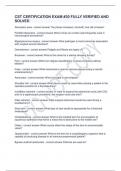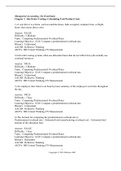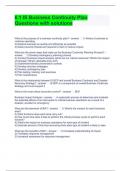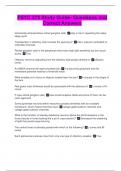Book summary
Chapter 3: social transitions
Adolescence as a social invention
Inventions= theorist who argue that the period of adolescence is mainly a social invention.
Although the biological and cognitive changes characteristics of the period are important in
their own right, adolescence is defined by the ways in which society recognize the period as
distinct from childhood or adulthood
Adolescence did not exist until the industrial revolution, and children were first treated as
miniature adults. There weren’t precise distinctions made among children of different ages.
Emerging adulthood: a new stage of life or a luxury of the middle class?
Emerging adulthood= the transition to adulthood has become so delayed in many IR
societies that some have argues that there is a new stage in life that may last until their mid-
20s. This unique developmental period is characterized by 5 main features:
1. Exploration of possible identities before making enduring choices.
2. Instability in work, romantic relationships and living arrangements.
3. A focus on oneself and, in particular, on functioning as an independent person.
4. Feeling of being between adolescence and adulthood.
5. The sense that life hold many possibilities.
,Chapter 6: Schools
Secondary education= middle schools, junior high schools and high schools. More wealthy
people go to school, but also in Africa 60% go to school.
The broader context of the US. Secondary education
There are more youngsters in school, they spend more days per year in school and they
remain longer in school.
3 historical / social trends change the rise of secondary education in America:
1. Industrialization more need for employers to be skilled and more worries for own
job and children new labor laws to protect jobs.
2. Urbanization poor households and crime. Education to reinform and improve live
quality and to hold social control.
3. Immigration: pledge for universal secondary education instead of being only for the
elite rise comprehensive high school
The No Child Left Behind (NCLB) require that all students, regardless of their economic
situation, achieve academic proficiency. They report the results of students’ performance.
Schools that keep failing, wouldn’t get funding. However there was criticism:
States: no resources to conduct assessment or to respond failing students.
Teachers / parents: focus on testing affect negatively the classroom.
Minority: there was social promotion for ethnic minority left out of good
education.
Critical thinking can’t be measured.
Shift on testing would discourage school form using assignments to improve
capacities
After NCLB there were more presidents who wants to improve school achievement:
1. Obama: fixed problems NCLB and started ‘race to the top’ of high quality teaching.
2. Trump: parents use government-funded education vouchers and choose school
wider gap quality schools.
3. Biden: reopening middle and high schools. Better schools have been funded.
Every school has to follow standards-based reform and adopt the common core. However
they’re flexible in how they implement the standard. Because many fail the exit test high
economic, social and political cost to hold them back low achievement test by school
standards-based reform failed look at other options like charter schools.
Inner-city schools have multiple problems:
1/3 of Black / Latinx goes to dropout factories.
Wide gap between Black-Latanix and White-Asian.
<20% students judged proficient in science implication success in high-tech eco.
There are several factors why school has reform failed in so many urban schools:
1. Concentration poverty inner-city has produced a population of students with
personal problems what schools can’t deal with
2. Urban school districts are burdened by administrative bureaucracies that impede
reform and hinder educational innovation.
3. Students report less sense of belonging to school disengagement and poor
achievement
4. Erosion of job opportunities in inner-city left students with little incentive to remain
in school or to devote effort to academic pursuits.
, The social organization of schools
Debates going on in organizing secondary schools. 5 key aspect of school organization:
1. School and classroom size: school size affect students mostly with bad grades. Ideal
size 600-900 students.
Lager school prove more varied curriculum lower changes to get on a team.
Also more schools within schools more positive social environment, but
more change of educational inequality.
Small school better for student performance, school interest, school
attachment, equality in educational experience. More positions in leadership
and responsibility.
However, only young elementary school children benefit from small classes not
adolescence. Only situations that call for individualized instructions or tutoring need
smaller classed and has positive effect at high school students.
2. Different approach to age grouping: the two-school model gets more popularity than
junior high school and middle school, because the higher achievement and lower
behavioral problems.
Academic motivation, school engagement and grades drop between
elementary – middle / junior high school, due changes grading practices. The
drop in performance is because the failure to satisfy developmental needs
disengaging more behavioral problems.
Teachers in junior high school want control, while adolescents want
independence mismatch needs drop achievement motivation.
Teachers differ due the bureaucratic organization and anonymity of junior
high schools, which affects the way they interact with students.
Students with more academic and psychosocial problems before making
transition, are less social competent, has fewer social support (teachers /
parents) and moving to impersonal school more susceptible negative effect
transition.
3. Tracking, or the grouping of students in classes according to their academic abilities:
Pro’s: classes more tuned to students’ abilities
Con’s: remedial track receive worse education than advanced tracks,
socialize peers only from the same academic group (polarize), decision
discriminate against poor and ethnic minority (especially black with math).
However the discrimination is mixed: parents white more involved in
children’s track.
Early track placements is often difficult to change without parents. Being
placed in more advanced track has positive influence on school achievement,
subsequent course selection and on ultimate educational attainment.
students who need most help are placed in low tracks limits learning.
Tracking has positive effects on the achievement of high-track students,
negative effects on low-track students, and negligible effects on students in
the middle. By classroom ability tracking, high ability higher expectations for
achievement and gets higher evaluation teachers, for low otherwise.
gifted students (IQ>134) and those with learning disability like dyslexia,
dysgraphia and dyscalculia are best served in mainstreaming than separate
classes more positive academic self-conceptions, foster social isolation
Chapter 3: social transitions
Adolescence as a social invention
Inventions= theorist who argue that the period of adolescence is mainly a social invention.
Although the biological and cognitive changes characteristics of the period are important in
their own right, adolescence is defined by the ways in which society recognize the period as
distinct from childhood or adulthood
Adolescence did not exist until the industrial revolution, and children were first treated as
miniature adults. There weren’t precise distinctions made among children of different ages.
Emerging adulthood: a new stage of life or a luxury of the middle class?
Emerging adulthood= the transition to adulthood has become so delayed in many IR
societies that some have argues that there is a new stage in life that may last until their mid-
20s. This unique developmental period is characterized by 5 main features:
1. Exploration of possible identities before making enduring choices.
2. Instability in work, romantic relationships and living arrangements.
3. A focus on oneself and, in particular, on functioning as an independent person.
4. Feeling of being between adolescence and adulthood.
5. The sense that life hold many possibilities.
,Chapter 6: Schools
Secondary education= middle schools, junior high schools and high schools. More wealthy
people go to school, but also in Africa 60% go to school.
The broader context of the US. Secondary education
There are more youngsters in school, they spend more days per year in school and they
remain longer in school.
3 historical / social trends change the rise of secondary education in America:
1. Industrialization more need for employers to be skilled and more worries for own
job and children new labor laws to protect jobs.
2. Urbanization poor households and crime. Education to reinform and improve live
quality and to hold social control.
3. Immigration: pledge for universal secondary education instead of being only for the
elite rise comprehensive high school
The No Child Left Behind (NCLB) require that all students, regardless of their economic
situation, achieve academic proficiency. They report the results of students’ performance.
Schools that keep failing, wouldn’t get funding. However there was criticism:
States: no resources to conduct assessment or to respond failing students.
Teachers / parents: focus on testing affect negatively the classroom.
Minority: there was social promotion for ethnic minority left out of good
education.
Critical thinking can’t be measured.
Shift on testing would discourage school form using assignments to improve
capacities
After NCLB there were more presidents who wants to improve school achievement:
1. Obama: fixed problems NCLB and started ‘race to the top’ of high quality teaching.
2. Trump: parents use government-funded education vouchers and choose school
wider gap quality schools.
3. Biden: reopening middle and high schools. Better schools have been funded.
Every school has to follow standards-based reform and adopt the common core. However
they’re flexible in how they implement the standard. Because many fail the exit test high
economic, social and political cost to hold them back low achievement test by school
standards-based reform failed look at other options like charter schools.
Inner-city schools have multiple problems:
1/3 of Black / Latinx goes to dropout factories.
Wide gap between Black-Latanix and White-Asian.
<20% students judged proficient in science implication success in high-tech eco.
There are several factors why school has reform failed in so many urban schools:
1. Concentration poverty inner-city has produced a population of students with
personal problems what schools can’t deal with
2. Urban school districts are burdened by administrative bureaucracies that impede
reform and hinder educational innovation.
3. Students report less sense of belonging to school disengagement and poor
achievement
4. Erosion of job opportunities in inner-city left students with little incentive to remain
in school or to devote effort to academic pursuits.
, The social organization of schools
Debates going on in organizing secondary schools. 5 key aspect of school organization:
1. School and classroom size: school size affect students mostly with bad grades. Ideal
size 600-900 students.
Lager school prove more varied curriculum lower changes to get on a team.
Also more schools within schools more positive social environment, but
more change of educational inequality.
Small school better for student performance, school interest, school
attachment, equality in educational experience. More positions in leadership
and responsibility.
However, only young elementary school children benefit from small classes not
adolescence. Only situations that call for individualized instructions or tutoring need
smaller classed and has positive effect at high school students.
2. Different approach to age grouping: the two-school model gets more popularity than
junior high school and middle school, because the higher achievement and lower
behavioral problems.
Academic motivation, school engagement and grades drop between
elementary – middle / junior high school, due changes grading practices. The
drop in performance is because the failure to satisfy developmental needs
disengaging more behavioral problems.
Teachers in junior high school want control, while adolescents want
independence mismatch needs drop achievement motivation.
Teachers differ due the bureaucratic organization and anonymity of junior
high schools, which affects the way they interact with students.
Students with more academic and psychosocial problems before making
transition, are less social competent, has fewer social support (teachers /
parents) and moving to impersonal school more susceptible negative effect
transition.
3. Tracking, or the grouping of students in classes according to their academic abilities:
Pro’s: classes more tuned to students’ abilities
Con’s: remedial track receive worse education than advanced tracks,
socialize peers only from the same academic group (polarize), decision
discriminate against poor and ethnic minority (especially black with math).
However the discrimination is mixed: parents white more involved in
children’s track.
Early track placements is often difficult to change without parents. Being
placed in more advanced track has positive influence on school achievement,
subsequent course selection and on ultimate educational attainment.
students who need most help are placed in low tracks limits learning.
Tracking has positive effects on the achievement of high-track students,
negative effects on low-track students, and negligible effects on students in
the middle. By classroom ability tracking, high ability higher expectations for
achievement and gets higher evaluation teachers, for low otherwise.
gifted students (IQ>134) and those with learning disability like dyslexia,
dysgraphia and dyscalculia are best served in mainstreaming than separate
classes more positive academic self-conceptions, foster social isolation











